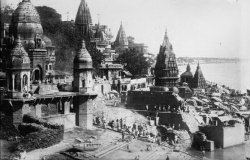Difference between revisions of "Vārāṇasī"
(Created page with "thumb|250px| Vārāṇasī, often anglicized as Benares, is Hinduism's mosts sacred city. Its name is derived from the fact that the ancient city was ori...") |
|||
| Line 1: | Line 1: | ||
[[File:Varanasi.jpg|thumb|250px|]] | [[File:Varanasi.jpg|thumb|250px|]] | ||
| − | Vārāṇasī, often anglicized as Benares, is Hinduism's mosts sacred city. Its name is derived from the fact that the ancient city was originally situated between two small tributaries of the Ganges, the Varna and the Asi. To die in Vārāṇasī or to bathe in the Ganges there is the goal of every devote Hindu. In the Tipiṭaka Vārāṇasī is called Kasi, the city's oldest name, or Bārānasī (D.II,146). The city has long been a centre of religious learning, culture and trade, especially trade in luxury goods. The Buddha said that before he renounced the world he only wore clothes made from Kasi cloth and used sandalwood from Kasi (A.I,145). Numerous Jātaka stories are set in Vārāṇasī or are said to have taken place when 'Brahmadatta was king of Bārāṇasī'. | + | [[Vārāṇasī]], often anglicized as [[Benares]], is Hinduism's mosts [[sacred]] city. Its name is derived from the fact that the ancient city was originally situated between two small tributaries of the [[Ganges]], the [[Varna]] and the Asi. To [[die]] in [[Vārāṇasī]] or to bathe in the [[Ganges]] there is the goal of every devote [[Hindu]]. In the [[Tipiṭaka]] [[Vārāṇasī]] is called [[Kasi]], the city's oldest name, or [[Bārānasī]] (D.II,146). The city has long been a centre of [[religious]] {{Wiki|learning}}, culture and trade, especially trade in luxury goods. The [[Buddha]] said that before he renounced the [[world]] he only wore [[clothes]] made from [[Kasi]] cloth and used {{Wiki|sandalwood}} from [[Kasi]] (A.I,145). Numerous [[Jātaka]] stories are set in [[Vārāṇasī]] or are said to have taken place when '[[Brahmadatta]] was [[king]] of Bārāṇasī'. |
| − | Archeological investigations have shown that there was a Buddhist presence in Vārāṇasī in ancient times but it was always overshadowed by Hinduism. Isipatana, where the Buddha preached his first and second discourses and now called Sārnāth, is just beyond Vārāṇasī's outer suburbs. | + | Archeological investigations have shown that there was a [[Buddhist]] presence in [[Vārāṇasī]] in ancient times but it was always overshadowed by [[Hinduism]]. [[Isipatana]], where the [[Buddha]] preached his first and second discourses and now called [[Sārnāth]], is just beyond Vārāṇasī's outer suburbs. |
{{R}} | {{R}} | ||
[http://www.buddhisma2z.com/content.php?id=510 www.buddhisma2z.com] | [http://www.buddhisma2z.com/content.php?id=510 www.buddhisma2z.com] | ||
Revision as of 01:50, 4 September 2013
Vārāṇasī, often anglicized as Benares, is Hinduism's mosts sacred city. Its name is derived from the fact that the ancient city was originally situated between two small tributaries of the Ganges, the Varna and the Asi. To die in Vārāṇasī or to bathe in the Ganges there is the goal of every devote Hindu. In the Tipiṭaka Vārāṇasī is called Kasi, the city's oldest name, or Bārānasī (D.II,146). The city has long been a centre of religious learning, culture and trade, especially trade in luxury goods. The Buddha said that before he renounced the world he only wore clothes made from Kasi cloth and used sandalwood from Kasi (A.I,145). Numerous Jātaka stories are set in Vārāṇasī or are said to have taken place when 'Brahmadatta was king of Bārāṇasī'. Archeological investigations have shown that there was a Buddhist presence in Vārāṇasī in ancient times but it was always overshadowed by Hinduism. Isipatana, where the Buddha preached his first and second discourses and now called Sārnāth, is just beyond Vārāṇasī's outer suburbs.
